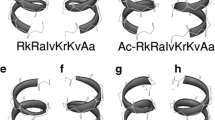Abstract
Diversity of sequence and structure in naturally occurring antimicrobial peptides (AMPs) limits their intensive structure–activity relationship (SAR) study. In contrast, peptidomimetics have several advantages compared to naturally occurring peptide in terms of simple structure, convenient to analog synthesis, rapid elucidation of optimal physiochemical properties and low-cost synthesis. In search of short antimicrobial peptides using peptidomimetics, which provide facile access to identify the key factors involving in the destruction of pathogens through SAR study, a series of simple and short peptidomimetics consisting of multi-Lys residues and lipophilic moiety have been prepared and found to be active against several Gram-negative and Gram-positive bacteria containing methicillin-resistant Staphylococcus aureus (MRSA) without hemolytic activity. Based on the SAR studies, we found that hydrophobicity, +5 charges of multiple Lys residues, hydrocarbon tail lengths and cyclohexyl group were crucial for antimicrobial activity. Furthermore, membrane depolarization, dye leakage, inner membrane permeability and time-killing kinetics revealed that bacterial-killing mechanism of our peptidomimetics is different from the membrane-targeting AMPs (e. g. melittin and SMAP-29) and implied our peptidomimetics might kill bacteria via the intracellular-targeting mechanism as done by buforin-2.






Similar content being viewed by others
Abbreviations
- AMPs:
-
Antimicrobial peptides
- TFA:
-
Trifluoroacetic acid
- DiSC35:
-
3,3′-Dipropylthiadicarbocyanine iodide
- ONPG:
-
O-nitrophenyl-β-galactoside
- MALDI-TOF MS:
-
Matrix-assisted laser-desorption ionization time-of-flight mass spectrometry
- RP-HPLC:
-
Reverse-phase high-performance liquid chromatography
- CFU:
-
Colony-forming unit
- MIC:
-
Minimal inhibitory concentration
- LUVs:
-
Large unilamellar vesicles
- MRSA:
-
Methicillin-resistant Staphylococcus aureus
References
Ahn M, Murugan RN, Jacob B, Hyun JK, Cheong C, Hwang E, Park HN, Seo JH, Srinivasrao G, Lee KS, Shin SY, Bang JK (2013) Discovery of novel histidine-derived lipo-amino acids: applied in the synthesis of ultra-short antimicrobial peptidomimetics having potent antimicrobial activity, salt resistance and protease stability. Eur J Med Chem 68:10–18
Alonso A, Garcia-del Portillo F (2004) Hijacking of eukaryotic functions by intracellular bacterial pathogens. Int Microbiol 7:181–191
Ando S, Mitsuyassu K, Soeda Y, Hidaka M, Ito Y, Matsubara K, Shindo M, Uchida Y, Aoyagi H (2010) Structure–activity relationship of indolicin, a Trp-rich antibacterial peptide. J Pept Sci 16:171–177
Bals R, Wilson JM (2003) Cathelicidins-a family of multifunctional antimicrobial peptides. Cell Mol Life Sci 60:711–720
Bocheva A, Nocheva H, Pavlov N, Todorov P, Calmes M, Martinez J, Naydenova E (2013) Synthesis and analgesic effects of novel β2-tryptophan hexapeptide analogs. Amino Acids 45:983–988
Bush K, Courvalin P, Dantas G, Davies J, Eisentein B, Huovine P, Jacoby GA, Kishony R, Kreiswirth BN, Kutter E, Lehner SA (2011) Tackling antibiotic resistance. Nat Rev Microbiol 9:894–896
Chongsiriwatana NP, Patch JA, Czyzewski AM, Dohm MT, Ivankin A, Gidalevitz D, Zuckermann RN, Barron AE (2008) Peptoids that mimic the structure, function, and mechanism of helical antimicrobial peptides. Proc Natl Acad Sci USA 105:2794–2799
Findlay B, Mookherjee N, Schweizer F (2013) Ultrashort cationic lipopeptides and lipopeptoids selectively induce cytokine production in macrophages. PLoS One 8:e54280
Ganz T (2003) Defensins: antimicrobial peptides of innate immunity. Nat Rev Immunol 3:710–720
Hancock R, Scott MG (2000) The role of antimicrobial peptides in animal defenses. Proc Natl Acad Sci USA 97:8856–8861
Hernandez-Gordillo V, Geisler I, Chmielewski J (2014) Dimeric unnatural polyproline-rich peptide with enhanced antibacterial activity. Bioorg Med Chem Lett 24:556–559
Jacob B, Kim Y, Hyun JK, Park IS, Bang JK, Shin SY (2014) Bacterial killing mechanism of sheep myeloid antimicrobial peptide-18 (SMAP-18) and its Trp-substituted analogue with improved cell selectivity and reduced mammalian cell toxicity. Amino Acids 46:187–198
Kim J-K, Lee E, Shin S, Jeong K-W, Lee J-Y, Bae S-Y, Kim S-H, Lee J, Kim S, Lee D, Hwang J-S, Kim Y (2011) Structure and function of papiliocin with antimicrobial and anti-inflammatory activities isolated from the swallowtail butterfly Papilio xuthus. J Biol Chem 286:41296–41311
Lewis K (2012) Recover the lost art of drug discovery. Nature 485:439–440
Makovitzki A, Avrahami D, Shai Y (2006) Ultrashort antibacterial and antifungal lipopeptides. Proc Natl Acad Sci USA 103:15997–16002
Murugan RN, Jacob B, Kim EH, Ahn M, Seo JH, Cheong C, Hyun JK, Lee KS, Shin SY, Bang JK (2013a) Non hemolytic short peptidomimetics as a new class of potent and broad-spectrum antimicrobial agents. Bioorg Med Chem Lett 23:4633–4636
Murugan RN, Jacob B, Ahn M, Hwang E, Sohn H, Park HN, Lee E, Seo JH, Cheong C, Nam KY, Hyun JK, Jeong KW, Kim Y, Shin SY, Bang JK (2013b) De novo design and synthesis of ultra-short peptidomimetics having dual antimicrobial and anti-inflammatory activities. PLoS One 8:e80025
Nguyen LT, Chau JK, Perry NA, Boer LD, Zaat SA, Vogel HJ (2010) Serum stability of short tryptophan-and arginine-rich antimicrobial peptide analogs. PLoS One 5:e12684
O’Connell KM, Hodggkinso JT, Sore HF, Welch M, Salmon GP, Spring DR (2013) Combating multidrug-resistant bacteria: current strategies for the discovery of novel antibacterials. Angew Chem Int Ed Engl 52:10706–10733
Sharma RK, Reddy RP, Tegge W, Jain R (2009) Discovery of Trp-His and His-Arg analogues as new structural classes of short antimicrobial peptides. J Med Chem 52:7421–7431
Tossi A, Sandri L, Gianqaspero A (2000) Amphipathic, alpha-helical antimicrobial peptides. Biopolymers 55:4–30
Yu H, Huang KC, Yip BS, Tu CH, Chen HL, Cheng HT, Cheng JW (2010) Rational design of tryptophan-rich antimicrobial peptides with enhanced antimicrobial activities and specificities. Chembiochem 11:2273–2282
Zasloff M (2002) Antimicrobial peptides of multicellular organisms. Nature 415:389–395
Acknowledgments
This work was supported in part by Korea Basic Science Institute’s research grant T34418 (J.K.B), the Next-Generation BioGreen 21 Program (#PJ009594, N.H.K), Rural Development Administration, Republic of Korea and Korea Research Foundation funded by the Korean Government (KRF-2011-0009039 to S.Y.S.).
Conflict of interest
The authors have declared that there is no conflict of interest.
Author information
Authors and Affiliations
Corresponding authors
Additional information
M. Ahn and B. Jacob contributed equally to this work.
Rights and permissions
About this article
Cite this article
Ahn, M., Jacob, B., Gunasekaran, P. et al. Poly-lysine peptidomimetics having potent antimicrobial activity without hemolytic activity. Amino Acids 46, 2259–2269 (2014). https://doi.org/10.1007/s00726-014-1778-z
Received:
Accepted:
Published:
Issue Date:
DOI: https://doi.org/10.1007/s00726-014-1778-z




